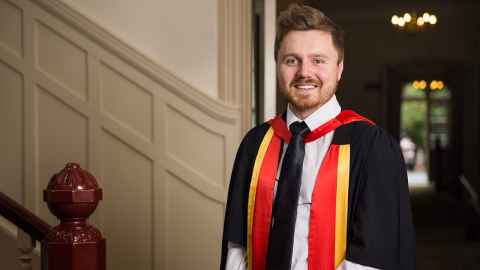If the glove fits, then let the hand talk to the robot
27 September 2019
The day after Christopher Walker graduated with his PhD in Bioengineering from the Auckland Bioengineering Institute, he was on a plane to Croatia, to test the glove he has developed to communicate with a robot, underwater.

Dr Walker has a background in electrical, civil, engineering science, and mechanical engineering principles and how they relate to the human body.
Earlier this year he and his colleague, Derek Orbaugh (who is currently doing his PhD at the ABI) won first place (and 1000 euros) in a technology demonstration at the EuroEAP conference in Dresden, Germany.
The conference challenges all research groups working with EAP materials (electroactive polymers which are soft and stretchy smart materials) to demonstrate a practical application of the technology.
They demonstrated how they could use EAP-based sensors, which characterise and recognise human movement, in a glove, to enable a person to communicate with a virtual under-water robot, commanding it to do things with certain hand gestures.
The research began in 2018 as a collaboration between the University of Zagreb, Croatia, and the Biomimetics Lab at the ABI, funded through a grant from the Office of Naval Research in the US.
As Dr Walker notes, the underwater environment is stunning and beautiful, but diving into it carries great risk, especially if you’re on your own. “One of the major risk factors is getting separated from your diving buddy,” says Dr Walker, pointing out that it can get very cloudy and murky deep in the ocean. His research is aimed at enabling divers to communicate with a robotic diving buddy through particular hand gestures.
As you soon as you do something underwater, it becomes more complicated
“As we imagine it, a robot that will have capabilities to visualise the diver and their orientation, perform basic tasks for the diver, monitor vital signs and report back to people on the surface and so on.”
“The challenge is to programme the sensors to recognise gestures that divers might typically use when diving, and to enable those sensors to control an underwater drone,” he says. “So it’s about a diver being able to communicate with the intuitive language that divers typically use, to manipulate the drone with the glove.”
Dr Walker has demonstrated that they can make the glove communicate with a robot, and make it do different things in response to certain hand gestures , having developed the algorithms so that the robot recognises what the gloved hand is doing, and also what the robot should do in response.
However “as soon as you do something underwater, it becomes more complicated.” Which is why he and Mr Orbaugh have in recent months focused on waterproofing the electronics, which they and other divers are now testing underwater in Croatia. Watch this underwater space.
“Technology in this area hasn’t really improved that much in the years since Derek and I have been diving,” says Dr Walker. “Wetsuits have improved a lot, and are really good, but what has excited us is enhancing the capabilities of what divers can do.”
Media contact
Margo White I Media adviser
DDI 09 923 5504
Mob 021 926 408
Email margo.white@auckland.ac.nz
Want to help us make a difference?
There are many ways you can make a difference and support the Auckland Bioengineering Institute - you can make a donation or bequest, or even subscribe to our newsletter.